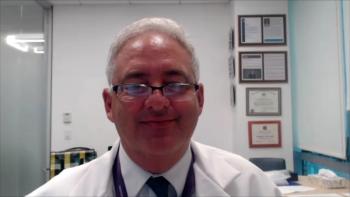
Comparing Treatment Outcomes in Eyes With Proliferative Diabetic Retinopathy and NVE, NVD
Disc neovascularization (NVD) was less frequent among patients with proliferative diabetic retinopathy but was associated with more resistance to currently available treatments compared with neovascularization elsewhere (NVE), according to post hoc analysis findings published in JAMA Ophthalmology.
Disc neovascularization (NVD) was less frequent among patients with proliferative
Data also showed that aflibercept was superior to panretinal photocoagulation (PRP) when treating NVE, but at 52 weeks, neither treatment was particularly effective against NVD, highlighting the need for future therapies targeting the condition, authors wrote.
For over 40 years, PRP has been the standard treatment for high-risk PDR. However, research has shown that anti-vascular endothelial growth factor (VEGF) agents are also effective in treating the condition.
Using data from the Clinical Efficacy and Mechanistic Evaluation of Aflibercept for Proliferative Diabetic Retinopathy (
“The CLARITY trial is a phase 2b randomized clinical, single-masked, multicenter noninferiority trial that compared the 1-year visual function outcomes of aflibercept vs PRP for the treatment of PDR in patients with type 1 or 2 diabetes,” authors explained. All patients included in the analysis subset were recruited from 22 ophthalmic centers across the United Kingdom, had treatment-naïve eyes with PDR at enrollment, and were 18 years or older.
Presence of NVD and NVE was detected via color fundus photography at baseline, after 12 weeks, and after 52 weeks. A total of 120 participants with a mean (SD) age of 54.8 (14.6) years were included in the analysis. The majority (n = 75) were male and there was a 1:1 ratio of eyes to patients. Baseline analyses showed NVD with or without NVE was present in 42 eyes (35%), whereas 78 eyes (65%) had NVE only. NVE also had a predilection for the nasal quadrant (64 [53.3%]) at baseline.
Researchers found:
- Rates of regression with treatment were higher among eyes with NVE (89 of 102 [87.3%]) compared with eyes with NVD (23 of 43 [53.5%]) by 52 weeks.
- At 52 weeks, NVD was more resistant to either treatment and had higher rates of persistence than NVE (20 of 39 [51.3%] vs 29 of 100 [29.0%]).
- Considering NVE, the regression rate in the temporal quadrant was lowest (32 of 42 [76.2%]).
- Eyes treated with aflibercept had higher rates of NVE regression compared with those treated with PRP (50 of 52 [96.2%] vs 39 of 50 [78.0%]; difference, 18.2% [95% CI, 5.5%-30.8%]; P = .01)
- No difference was found among eyes with NVD (11 of 17 [64.7%] vs 12 of 26 [46.2%]; difference, 18.6% [95% CI, –11.2% to 48.3%]; P = .23).
- The proportion of eyes with persistent NVD (51.3%) despite treatment was nearly double that of eyes with persistent NVE (29.0%) at week 52.
Mean diabetes duration was 25.2 (10.5) years among patients. Findings underscore the importance of screening for NVD and accurately classifying the severity of PDR, authors said, as “severity has direct implications on treatment frequency and response.”
Overall, at baseline there was a higher proportion of eyes with NVE than NVD, whereas during follow-up, more new occurrences of NVE than NVD were recorded.
Researchers hypothesized that the origin of NVD could explain the differential response of NVD to treatments, as some may be of ciliary origin rather than retinal origin.
In addition, “The topographical response with regression of NVE in all quadrants except the temporal region with intravitreal aflibercept, with fewer eyes in the PRP group exhibiting similar levels of regression, supports the view that anti-VEGF therapy represents an improved form of treatment,” researchers wrote.
The relatively short duration of the study does not reflect long-term treatment needs of PDR, marking a limitation. The sample size for eyes with NVD was also smaller than those with both NVE and NVD. Future studies with larger sample sizes are needed to confirm findings.
Reference
Halim S, Nugawela M, Chakravarthy U, et al. Topographical response of retinal neovascularization to aflibercept or panretinal photocoagulation in proliferative diabetic retinopathy: post hoc analysis of the CLARITY randomized clinical trial. JAMA Ophthalmol. Published online March 11, 2021. doi:10.1001/jamaophthalmol.2021.0108
Newsletter
Stay ahead of policy, cost, and value—subscribe to AJMC for expert insights at the intersection of clinical care and health economics.

















































